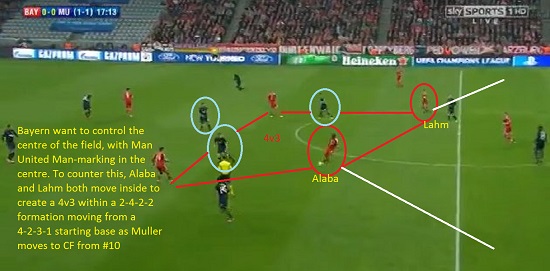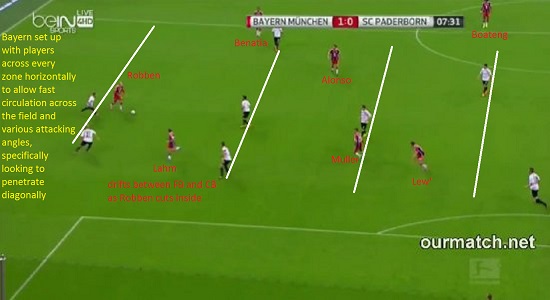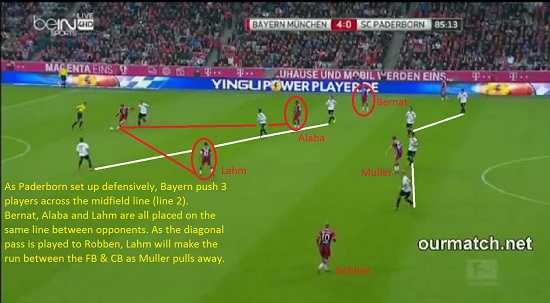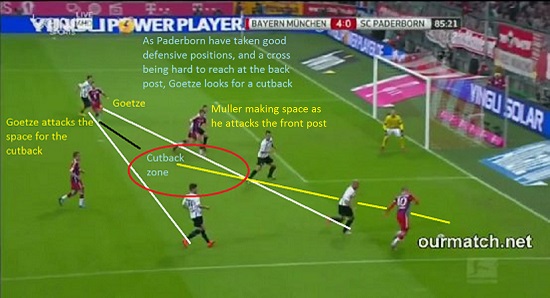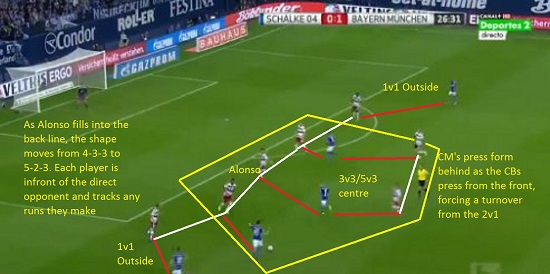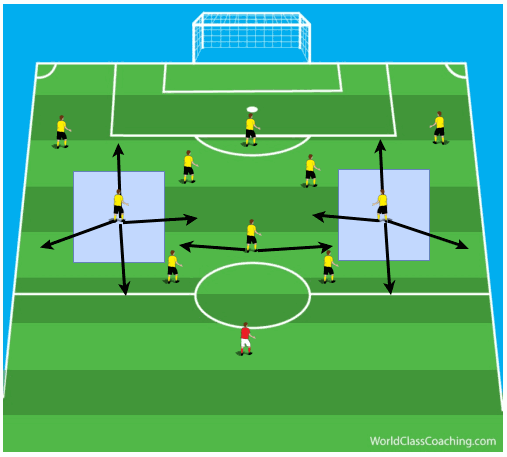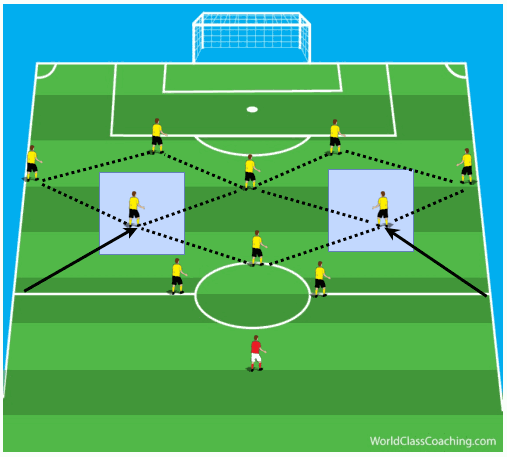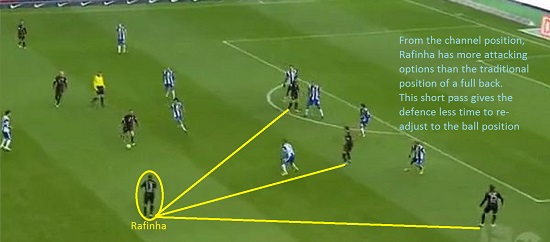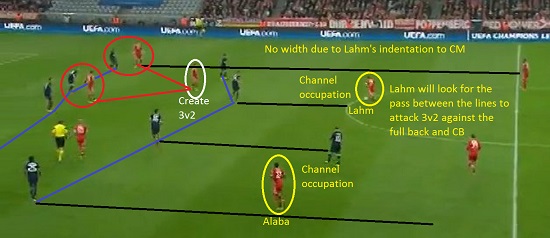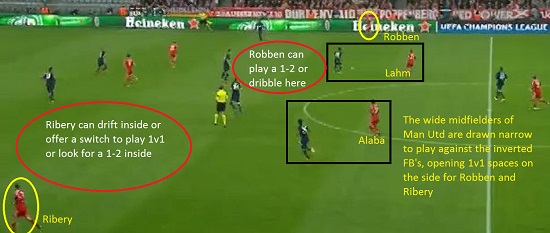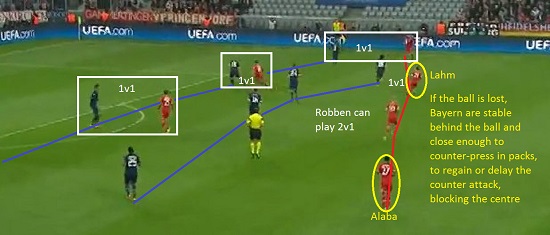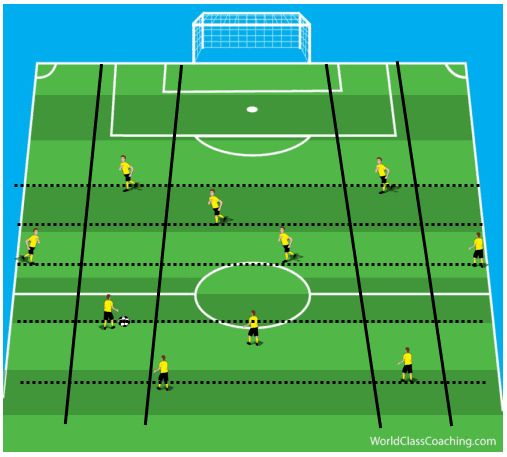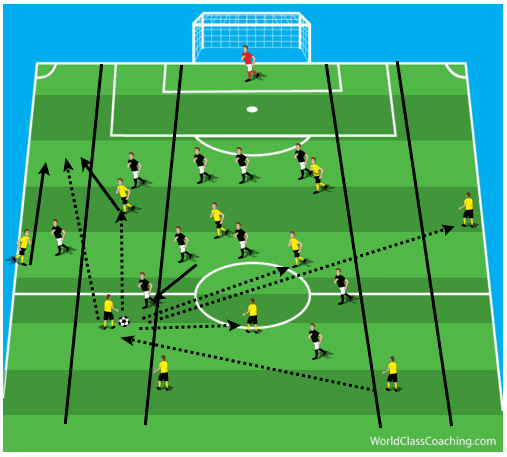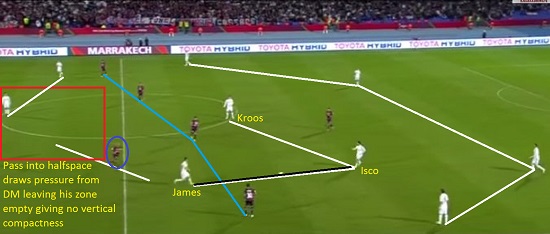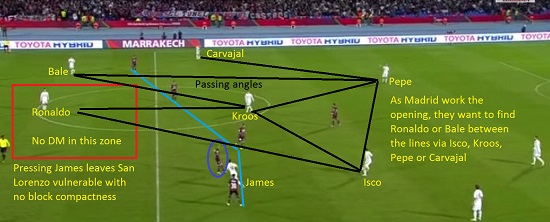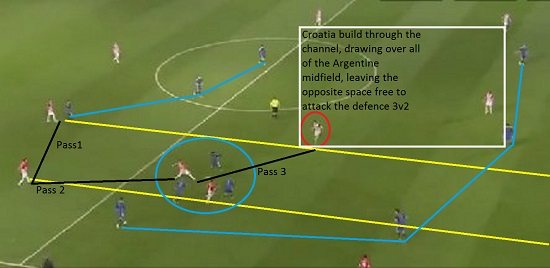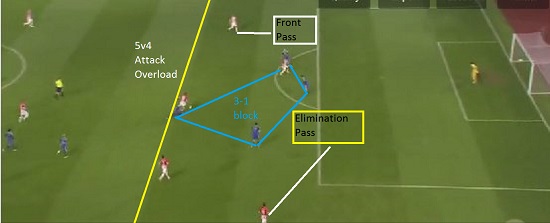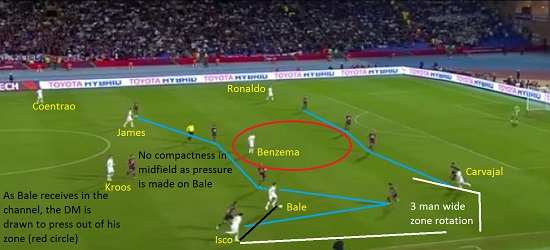Part Three
- Playing with Inverted Full Backs
- Bayern's Move from Fixed to Flexible
- Using the Channel to Draw the Defense Over
Playing with Inverted Full Backs
Positioning in modern football is a massive part of the success of a team, particularly in the development of an attacking game but also in ball conservation to defend, while defensive positioning has always been an important factor in a successful defensive unit. With Pep Guardiola (of whom regular blog readers will know I analyse his teams on a regular basis), his tactical innovations are changing the way the game is played and coached across all levels.
Inverted Full Backs to overload the centre and cover several zones with one player
The full backs of Bayern – Alaba and Lahm – can both be played in central midfield and at full back in both attacking and defensive phases. This gives Guardiola so many more options but instead of being a traditional coach and using players in traditional roles, he has created a hybrid position for these players – an ‘inverted Full Back’ role, where in defensive phases, they retreat to defend the sides like regular full backs, but can also stay centrally to cover behind the counter-press, able to cover more zones from a position in the ‘channel’ as opposed to from the touchline.
This works on the basis that you have less attacking and defensive movement areas from the touchline. Instead, playing these players in the channel as hybrid central midfielders and full backs where they can move inside and impact the game in all 4 phases, while being able to cover both the middle and sides with a quick 15m sprint gives Bayern many more movement options.
In this example, Alaba and Lahm help overload the centre 4v3 as Bayern move from a 4-2-3-1 to a 2-4-2-2/2-2-4-2 means that Bayern can cover more zones and keep the team compact in both attack and defensive phases.
When the ball is lost, Bayern counter-press leaving Alaba and Lahm to cover behind the press as it is forced into the centre, but if play escapes the press to the side, they are mobile enough to shift over and cover the spaces on the sides.
Positioning Across The Field – Covering each Vertical Zone, Horizontally
When in possession, each player has a ‘playing group’ of 2-4 players.
For example; Robben, Rafinha, Lahm on the right, Alonso, Lahm, Alaba in the centre and Alaba, Goetze and Bernat on the left.
- Across the field, there are 2 ‘wall players’ – Rafinha and Bernat
- There are 2 ‘hybrid players’ - Lahm and Alaba who can cover multiple zones
- There are 2 ‘penetrating players’ - Robben and Goetze who can dribble and position inside between the lines
- The Holding player; Alonso, covers laterally behind the play to continually offer passing angles
Positioning to penetrate to attack the back 4 from midfield
As Alonso is deepest of the midfield triangle, both Lahm and Alaba are between opponents on line 2, with Bernat on the outside of the midfield line. The positioning of these 3 players is key to breaking through the midfield line, as any pass which is received on the half turn can allow for the next pass to go through the back 4 if the movement ahead is on time, while if a switch of play is made, Lahm and Alaba are in good supporting positions to run ahead of or around the defensive line.
Movement to offer and attack a cutback
Crossing is often unsuccessful and leaves you open to a quick counter attack if the GK is quick in releasing the ball after a catch. A good way to score without the risk of the counter attack is to make cutbacks while the back 4 are running back, facing their own goal.
Here, Goetze recognises that Robben likely won’t cross to the space at the back post as Muller is on his way to the front post, while the cutback angle is available between the centre backs as the near post defender covers the front zone. We can see by Goetze’s body shape that he is already on the run and expects Robben to make a cutback.
Bayern Defensive shape in a 4-3-3 or situational 5-2-3 variant
Alonso is the deep player in the midfield triangle of the 4-3-3, or even when there is a 3-3-3-1, he will often fill into the back 4 or fill in to create a back 3, or even make a back 5 when needed. In this instance, Schalke have gained ground and picked up good positions between the lines infront of the defence. As there are 3 players between the lines in the central zone, Alonso fills into the defensive line and form a situational back 5.
The key to this is that each player has an opposition player of whom they have to play against 1v1, 3v3/5v3 in the centre and 1v1 on the outsides. The CMs who are deep have to press from behind and cover the space infront of the player in possession, while blocking any penetration opportunities whilst maintaining a clear defensive line to ensure the team can hold positions to halt the progress of the runners who can be caught offside.
Bayern's Move from Fixed to Flexible
Pep Guardiola has evolved the Bayern Munich team over the 18 months he has been in charge so it is almost unrecognisable from the treble winning team and style Jupp Heynckes left behind. The system has changed so much that the fairly rigid positions of each player has been replaced with a solutions to problems based style, and one major change has been the implementation of ‘inverted full backs’ in the manner that they cover 4 positions from 1 zone, almost like an old fashioned ‘halfback’ from the 1930s.
The positioning of this player allows the team to be flexible in the centre and wide areas, in both attack and defence, and in transition phases where the ‘halfbacks’ can drop off to form a back 4, or press high to counter-press with the 2-1 triangle covering behind them (DM & CBs).
Position of the ‘inverted Full Backs / Halfbacks in a 4-3-3
As we can see, the ‘halfback’ is in the position between centre and wide (the channel) between midfield and defence, providing positional flexibility while other positions appear to be ‘fixed’.
In reality, the Guardiola system provides incredible flexibility and movement between players, working on the premise of looking for overloads and creating diamonds between players. The narrower positioning of the fullbacks/halfbacks provides this.
Angles of attack form the channel position
As Rafinha is in the ‘channel’, he can receive and attack closer to the goal with an outball to a 1v1 with options inside the box. The key here is that in a ‘normal’ FB position, the pass is longer and the defence have more time to adjust while the player has 2 or 3 touches. Here, he can attack 1st time.
Overloading the centre
Against a team playing in a 4-4-2, a 3v2 in central midfield is a common way to gain control in a 4-3-3 or 4-2-3-1. If a team plays a 4-4-1-1, the 3v3 in midfield means that lots of circulation and rotation is needed to gain control, so to find a way around this, a team may use a wide midfielder in a more narrow position to gain control 4v3. This can draw the opposition narrower than the attack would like, so the Guardiola solution os to push both FB’s into the centre, leaving the wide midfielders to play on the same line as the opposition backs 4, either wide or central, offering more penetration choices. This also causes the wide midfielders of the opposition a problem – who do they mark? Do they track wide to the wide attacker and create a situational back 5 or back 6?
Normally as they would be narrow to play compact, they would defend 1v1 with the FB in the wide zone, but the flexible positioning of the full backs makes this a more difficult job than normal.
Looking for penetration opportunities
Lahm and Alaba’s positioning is very deliberate here; they play in the channel which can provide a straight pass into the halfspace to penetrate the midfield on line 2 (between players on the midfield line) or line 3 (between the lines of defence and midfield).
In this example, Lahm wants to find the pass into line 3 where a 3v2 can occur due to the positioning of the attackers on line 4 (against the defence).
Forcing the opponent to lose shape and open up spaces
Isolating the winger who is excellent in 1v1 play by drawing the wide midfielder inside is a difficult task if the full back stays wide as the direct opponent will drop back to help the full back. Instead, by moving inside and drawing the wide midfielder with him, this narrows the midfield and leaves the winger 1v1 against the opposing full back.
Covering positions ahead of defensive transition
With the movement to indent to play centrally, this reduces the distances between players, covering the width of the field in transition to allow the team to counter-press from a stable position. If the far side full back was wider, there would be a gap between players and leave a space which could be exposed centrally. Instead, with the central positioning, this can block forward passes and force the attack to go around the press, making the route to goal potentially slower and in-direct.
Using the Channel to Draw the Defense Over
Traditionally in football, the field was separated into 3 clear areas – wide-centre-wide, meaning the specific positional play in possession was fairly static. With a field around 60m wide, this means that each zone is 20m wide, often resulting in large distances between players, particularly in a traditional 4-4-2 formation.
If we split the field into 5 clear channels, this distances of width of each zone becomes 15m and the 5m reduction of distances help layers cover more ground collectively and individually, so the ‘channel’ has become a key zone in terms of build-up play and in how to penetrate through defences.
Using the channel draws over players to press diagonally, and normally results in space being opened up either behind the inside central midfielder or the wide midfielder, and often a defensive midfielder will come higher up to cover the space, leaving the zone between the lines free to be exploited, often temporarily hurting the vertical compactness of the defensive block.
To me, there has been a debate among British coaches and European coaches around the term ‘halfspace’, which is derived from the word ‘haufbraum’ used in Germany from the 1930s to describe ‘the channel’ as it was the area usually occupied by a ‘halfback’, hence the term, ‘halfspace’
For me, there is a difference between the channel and the halfspace;
- The channel is a set strip of field down the field, like the wing or the centre
- The halfspace is a movable space between 2 specific opposition players – wide and centre.
If a player presses out of position to the channel, they press diagonally leaving a space which can be exploited, particularly if the player in possession has 3 clear lines of play ahead of him.
As the ball is switched from channel to channel, the defensive block would need to quickly shift over and stay compact, while moving diagonally to press. There will always be a space available to pass the ball again to. The key is that the player receiving will know where the player he passes to will go next, with either a pass with the back to goal on line 4, a player able to turn and attack the back 4 on line 3, a player on the half turn to penetrate on line 2 or a player to take possession and pass forward on the same line. Often with Real Madrid, Isco or Modric play in the channel, draw pressure then use Kroos inside the centre circle to attack next.
As we can see, the player in the channel has 5 passing options, with a switch to the far side open for the far side full back to have a 3v2 on the side, a pass into the centre via the right central midfielder on line 2, a pass to feet of the left attacking midfielder on line 4 or 3 if he drops in, a pass behind the fullback into the corner, or a possibility to dribble into line 3 himself. If none of the forward options are available for him to give the next player a chance to continue forward, he might pass inside to the player on the same line that has a whole field to use and play forward.
Building from midfield into attack
Once play has been consolidated the midfield look to find a way into the attacking phase against the back 4. Isco passes to James who has drawn diagonal pressure from the DM, who leaves his zone to press James. As James makes a simple pass back to Isco, the ball is where it started 3 seconds ago but now with a hole between defence and midfield, with minimal horizontal compactness across the opposition midfield line, which Real Madrid should be able to penetrate.
As Isco receives the 2nd pass, we can see Ronaldo now has the whole of the #10 zone to himself, with no vertical compactness of the defensive block to be seen. The position of Toni Kroos is excellent, he is infront of the defensive line able to turn and play through to Ronaldo in the #10 zone or Bale in the channel. He could make an easy wide pass to Carvajal who would be expected to push up if Kroos recieves and the wide midfielder would tuck in to mark Bale; if he does not, he passes to Bale.
Drawing pressure to play diagonally between the lines
The build-up away from pressure into the channel draws over all 3 of Argentina’s central midfielders, leaving them exposed in front of the back 4. If the ball can be played diagonally into the player between the lines, Argentina will struggle to recover as the attack could possibly overload.
In the final 30m, Croatia have a 5v4, with Argentina trying to form a narrow 3-1 block to force play wide. As the wide runners are from close to the ball – the near side wide player is in the channel and has less running distance, he can be dangerous with a pass around the defence, while a reverse pass against the body shape of the defence into the yellow box would result in a 2v1 on the GK with the RW and CF.
Three man wide zone rotation via the channel
As we can see, Bale is in the zone expected of Isco, Carvajal in the zone expected of Bale and Isco in the zone of Carvajal, as all 3 have rotated to fine Bale in the channel.
As the DM again is forced to move over and out of position to press Bale, Benzema is free between the lines to offer a quick diagonal pass from the outside of Bale’s left foot, which would expose the back 4 with Ronaldo on the blindside and Bale running form deep with Carvajal occupying the full back.
Instead, Carvajal moves inside to create the wide space Isco will overlap into.
As Bale is pressed, he can pass inside but with the wide zone free and possibly less risky a pass, especially with 6 players taken out if the ball is lost and in a more dangerous position centrally for a counter attack, the wide pass to Isco on the overlap is the sensible pass with Isco having the ability to make a final pass.
We can see the importance of building through the channel to open up the defence and how we can penetrate if the team is well organised in their position vertically and horizontally.

